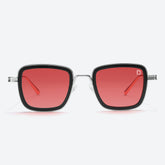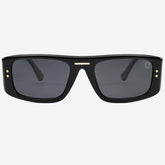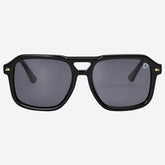What Are UV-Protected Sunglasses? Everything About UV400 Sunglasses
While sunlight is important for your body, it might be detrimental to your eyes. Sometimes, you'll even feel discomfort just seeing the reflection of sunlight on a building.
In that case, sunglasses can protect you from UV rays coming from the sun. But they don't necessarily stop harmful light.
Your glasses need to have a UV transmission rating to inform you of how effective they are. The glasses that block the most harmful light are UV400. But why do you need to filter UV light? And what happens if you don't?
In this blog post, you'll discover what UV protection sunglasses are and how UV400 sunglasses work in this scenario. Let’s delve deeper!
What Are UV Protection Sunglasses?

This type of eyewear has lenses with a coating that blocks harmful ultraviolet (UV) radiation. Among the three varieties of UV lights A, B, and C, the earth's atmosphere mostly takes out UVC. And so, you only need UV A and B radiation protection.
Sunglasses that claim to protect from UV light typically prevent these rays from entering the eyes or damaging the surrounding skin.
The glasses manufacturers coat these plastic or glasses lenses in a UVA and UVB-blocking substance. However, they do so to different degrees depending on your needs. For instance, the UV400 lenses stop 99% – 100% of these two UV rays. This rating means that these glasses block UV light up to 400 wavelengths which is the highest concern.
Alternatively, the European Union has a CE system that regulates the quality of sunglasses. Here's how much each type of glasses blocks UV light:
- C0: 0% – 20%
- C1: 20% – 57%
- C2: 57% – 82%
- C3: 82% – 92%
- C4: 92% – 97 %
And so, UV400 eyewear provides more protection than CE sunglasses.
The History of UV Protection Sunglasses
Since prehistoric times, humans have created glasses to lessen the effect of sun rays. These eyewear include Inuit goggles to reduce blindness from glare from the snow and 12th century Chinese Ai Tai quartz sunglasses.
However, these glasses didn't target UV rays specifically. The Inuit goggles greatly limited all light and the Ai Tai protected the eyes from glare.
It wouldn't be until 1899 that Rodenstock GmbH created the first glasses that specifically filter out UV light. From there, these glasses gained popularity through 1920s celebrities wearing them. Then, pilots started wearing these accessories in the 1930s. With such popular icons wearing these glasses, it's no wonder that they spread throughout American culture.
As for the material, it was cerium in 1913. This material completely filters out UV light. At the end of the 1920s, glasses manufacturing companies switched to cheaper celluloid. And the 1930s saw another development: Polarized lenses. Ten years later, companies used resin in sunglasses.
Now, companies use either polarized lenses, glass, or plastic. Additionally, poly-carbonate glasses filter out UV light. And so, safety glasses containing this material can protect your eyes from UV rays.
Additionally, these lenses come in a variety of colors depending on whether you need color contrast, lack of distortion, or visibility:
- Gray
- Green
- Yellow
- Blue
- Brown
- Purple
- Turquoise
What is UV400 Sunglasses?
UV400 sunglasses are designed to protect your eyes from harmful ultraviolet (UV) rays. They block 100% of UV rays up to 400 nanometers, which includes both UVA and UVB rays. This helps keep your eyes safe from sun damage.
These special sunglasses offer superior eye protection, especially important for outdoor activities like beach trips or sports. They prevent eye strain and reduce the risk of cataracts and other UV-related eye issues.
So, these sunglasses are a must-have for anyone spending time outdoors to ensure complete UV protection.
Why Should You Wear UV400 Sunglasses?

UV400 sunglasses are important to wear as they shield your eyes from the destructive reaction to sun rays. Typically, UVB light affects the cornea while UVA radiation penetrates the eyes to the retina.
Therefore, when you don't wear these glasses, you're risking both short-term and long-term eye complications such as sunburn.
Additionally, UV rays pass through clouds. And so, even if it's an overcast day you're still risking damage to your eyes and the surrounding area.
Plus, you need UV400 sunglasses in particular because they provide better coverage than your typical prescription eyewear. In particular, curved sunglasses with wide arms prevent rays from coming at different angles such as reflections.
Who Can Wear UV400 Sunglasses?

Everyone can wear sunglasses! So long as you step out into the sun, you should wear this accessory. However, you might need to wear them more than the average if you're a:
- Snowboarder
- Skier
- Mountain Climber
- Sun Tanner
- Welder
- Laser Operator
- Pilot
- Kayaker
- Astronaut
- Driver
These positions expose you to a higher dosage of UV rays for a prolonged duration. Therefore, it's essential to safeguard your eyes if any of the jobs and activities above concern you.
In some cases, you'll need stronger than average eyewear. For instance, glasses for skiing, welding, and laser operations are very dark.
Additionally, if you have the following eye problems, you may require glasses:
- Photophobia: This symptom causes sensitivity to light. And so, sunglasses help reduce the painful effect of exposure to light.
- Glaucoma: This is a collection of ocular diseases that impact your vision. By deteriorating your optic nerve, these diseases can lead to semi or complete blindness. However, in some cases, you can manage your glaucoma with sunglasses.
Plus, children should wear this eyewear when outdoors. Their eyes open wider and so take in more UV radiation than adults.
Do You Need UV400 Glasses?

You should use this type of eyewear. Even if it's a rainy day, UV rays pass through the clouds. So, as long as you go outside you should have glasses that fully block UVA and UVB.
If you have glasses that have polarization to avoid glare or to reduce the light entering the eye, you still need UV protection. Dark sunglasses with no UV protection may be worse for you. Since your pupils dilate when you're in the dark, they'll take in more UV radiation than if you weren't wearing them at all. Additionally, when you're using safety eyewear, you should ensure it has this rating too.
More specifically, you'll avoid short-term sun damage to your eyes: Photokeratitis. This is a sunburn to the cornea which makes your eyes red, puffy, and gritty.
Additionally, it can prevent long-term exposure damage like:
- Cataracts: This condition is a clouding of the lens.
- Snow Blindness: When you're exposed to sun glare, you can get a short-term loss of vision. It's caused by the irritation of the cornea.
- Macular Degeneration: This condition is the progressive deterioration of central vision from damage to the retina.
- Eyelid Cancer: You'll avoid these tumors by reducing UV exposure to the skin around your eyes.
Are UV-Protected Glasses Better than Polarized Glasses?
In truth, it's not a question of whether they're better, these accessories do a different job.
Since 1936, polarized glasses have prevented sun glare. And so, these glasses reduce the quantity of rays that penetrate the eye. However, polarization alone doesn't protect from UV radiation.
Similarly, UV protection doesn't stop sun glares but you can get clear UV protection eyewear. And so, what matters is your visual comfort and what activity you plan on doing.
Nevertheless, you always need to protect yourself from UV light. And if you're in an environment with strong light, you'll need the polarization feature in your glasses.
UV400 Glasses in the 21st Century

Modern eyewear should have UV400 or 100% UVA/UVB protection. If you need to see exact colors, you can get clear glasses that fully protect you from the sun's radiation. These glasses should have a warped profile that will provide maximum coverage for your eyes. In other words, you should pick curved sunglasses rather than straighter prescription eyewear.
Nevertheless, you can have the UV400 feature even in your daily prescription glasses. That's especially useful if your vision requires correcting at all times. Like that, you can step out with your photochromic lenses. They'll darken under the sunlight automatically and block 100% of UV rays.
Additionally, you can add other features to these glasses such as a blue light filter or polarization. Though UV protection blocks some blue light, having the feature can reduce the effects of this spectrum of rays.
These glasses are also fashion statements. Whether you want iconic eyewear like Audrey Hepburn wore in the 1961 Breakfast at Tiffany's or the cool aviator sunglasses Robert De Niro flaunted in Taxi Driver in 1976, there are plenty of styles for you to pick. You just have to ensure that the UV protection is high enough and that you replace them after a few years since they degrade.
Conclusion
Now that you know what uv400 sunglasses are, it is important to know that this type of eyewear comes from a long line of innovation. From the Inuit snow goggles to the 1920s celluloid glasses, companies have refined this accessory to maximize UV protection and reduce cost. These glasses are not only fashion statements for celebrities, but also a necessary accessory for the common folk. These days, you can pair your UV protection with a blue light filter, polarization, and your prescription. Your glasses can even be clear or shift automatically as you desire!
Besides, you need to protect your eyes from sun radiation to avoid sunburns in your cornea, macular degeneration, eyelid cancer, and temporary blindness from glares. These glasses also help manage photophobia and glaucoma. But it's children that need them the most since they are more susceptible to UV rays.





